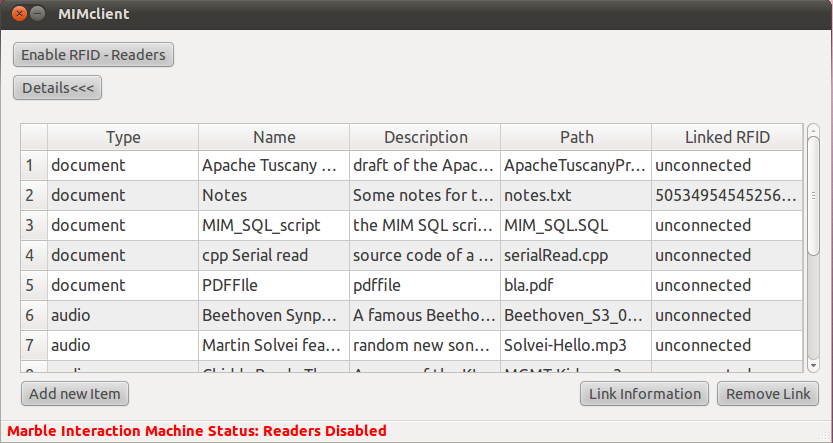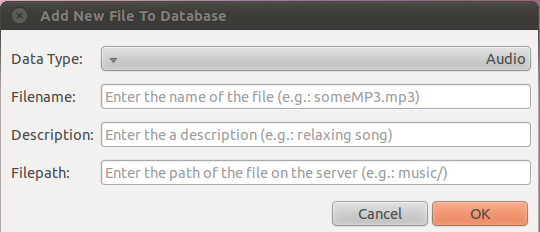Intelligent Systems Lab Project: Marble Interaction Machine
Participants
- Volkan Aksu
- Julian Einhaus
- Norman Köster
- Frank Lehmke
Supervisors
- René Tünnermann
Motivation
In some use contexts it is inconvenient to use a computer. For instance, people that work in front of the computer the whole day long for alternative interaction types when reviewing personal information in casual environments such as their living rooms.
Application Szenario
The user comes home after a long day of work and only wants to relax on his couch. Nevertheless, he wants to play his favourite music without being burdened by the complexity of controlling the media player at computer screen. He takes the green marble from the bowl and places it on the reader next to the couch. The green marbles are linked to classical music. The music begins to play in the background, the user closes his eyes and listens to the music.
Objectives
We want to build an intelligent system which is able to interact with the user via marbles in order to avoid the usage of the computer.
The project goals are- to develop a hard-/software system to enable the basic control (access) functionalities
- to implement a software that allows to associate various media types (such as audio, video or document) to marbles
- open of various media data
- delete/change/link and display information with an user interface which is easy to use
- stream media data
- design and implementation of four marble reading devices which are able to detect if a marble is placed on the reader
Description
We designed and implemented four reading devices which are able to read our custom-made marbles with integrated RFID tags. Arduino Diecimila boards and RFID reader were integrated into our devices. The RFID readers are powered via the USB port and connected to a computer. With the help of our software application the user can link/remove/add his media data to the marbles.



Figure1: RFID-Reader, Arduino, Marble with a RFID-Tag
After launching the software component "MIMclient-Window" you see a selection of different settings (Figure2).
In the upper left corner of the window there are two buttons. To enable or disable the RFID-Readers,
you click the first button "Enable RFID-Readers". If you want to hide details, you can click on the Button
"Details".
The database window consists of columns and rows with cells which contain linked/unliked
media files.The rows are numbered beginning with one. The columns shows type, name, description, path and linked
RFID of the added file.

At the bottom right of the database-window you can link the desired file to a marble. For this purpose you select an unconnected file in the database and click on the button "Link Information". If the RFID-Reader is enabled, you take a marble and place it on the reader. The ID of the marble is recognized and added to the database. Next to "Link information" button you see the button "Remove Link" which also enables to delete items from the database.
When you click the button "Add new item" on the bottom right, a menu appears in the following window (Figure3). Here you can use the menu to create a new file (audio, video or document) and add it to the database.

Results
We have built a novel tangible user interface with marbles used as tangible bits. For this we designed and implemented four reading devices which are able to identify our custom-made marbles with integrated RFID tags. Arduino boards and RFID reader were integrated into our devices. They use the standard USB port to get powered and connected to a computer. When marbles are put on the devices it will result in streaming a media file linked with this marble from our server. The streaming will last as long as the marble lies on the device. With the help of our software application the links between marbles and media files can be modified and new files can be added in the GUI.
Demonstration videoDiscussion and Conclusion
We have reached our goals (see above). But there were some points which we could have done better that described above if the hardware would have been delivered on time:
The missing hardware prevented us to build a marble dispensing device. More RFID-Readers would allow us to distribute them at different objects in the room, e.g. at monitors or at a music station. More marble would allow to test how users operate with the system where the user's memory is insufficient to associate the linked information to objects.Outlook
This project sets the basis for future extensions, of which we regard the following as most promising: The reading devices could get more mobile by removing the cable and adding a battery and Bluetooth or WiFi functionality. Another idea is to design an event driven marble device, ejecting marbles as soon as we receive an email, for example. To get away from the usage a computer for editing the links between media and marbles, the media files themselves could be represented by physical tokens and equipped with RFID tags. For example, the user's favourite music could be represented by it's cd cover and linked to a marble by placing both pieces to specific reading devices.



